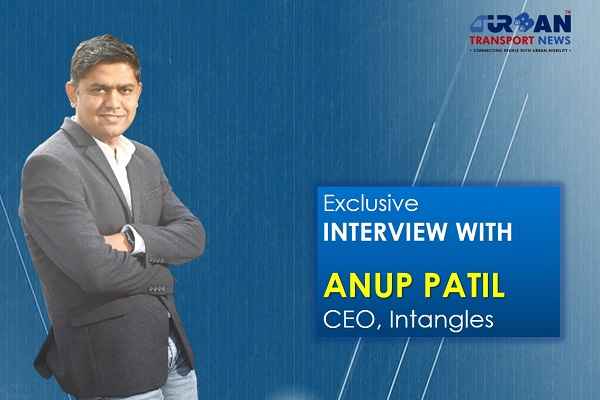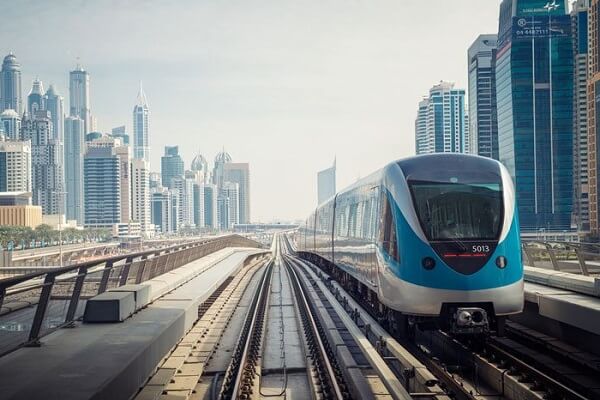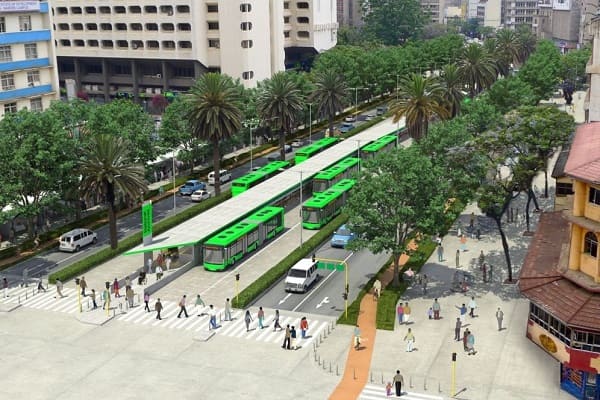 Delhi unveils ambitious Urban Mobility Vision: Luxury Metro Coaches, New Tunnels and Pod Taxi
Delhi unveils ambitious Urban Mobility Vision: Luxury Metro Coaches, New Tunnels and Pod Taxi Qatar approves Saudi Rail Link Agreement, Accelerating Gulf Railway Vision 2030
Qatar approves Saudi Rail Link Agreement, Accelerating Gulf Railway Vision 2030 UP Govt plans to introduce Water Metro services in Ayodhya, Varanasi & Prayagraj
UP Govt plans to introduce Water Metro services in Ayodhya, Varanasi & Prayagraj India’s First Urban Ropeway begins Trial Run in Varanasi, Set to carry 1 Lakh passengers daily
India’s First Urban Ropeway begins Trial Run in Varanasi, Set to carry 1 Lakh passengers daily India and Bhutan to Build First-Ever Rail Link: ₹4,033 Cr Project to Boost Regional Connectivity
India and Bhutan to Build First-Ever Rail Link: ₹4,033 Cr Project to Boost Regional Connectivity Patna to launch Eco-Friendly Water Metro; Trial Run soon between Digha and Kangan Ghats
Patna to launch Eco-Friendly Water Metro; Trial Run soon between Digha and Kangan Ghats Air India Group set to launch Flights Operations from Navi Mumbai International Airport
Air India Group set to launch Flights Operations from Navi Mumbai International Airport Chennai to launch 25-Year Mobility Plan with Unified QR Ticketing and One-App Transit System
Chennai to launch 25-Year Mobility Plan with Unified QR Ticketing and One-App Transit System Kochi Metro bags ₹4.4 crore contract to prepare DPR for Mumbai Water Metro Proejct
Kochi Metro bags ₹4.4 crore contract to prepare DPR for Mumbai Water Metro Proejct Navi Mumbai International Airport set for September launch; IndiGo and Akasa Air to lead Operations
Navi Mumbai International Airport set for September launch; IndiGo and Akasa Air to lead Operations
Exclusive interview with Anup Patil, Chief Executive Officer, Intangles

Anup Patil is the Chief Executive Officer (CEO) at Intangles, a leading solution provider that leverages its proprietary Digital Twin technology to provide real-time and predictive insights for the mobility industry.A visionary and a first-generation entrepreneur, Anup Patil spearheads the company’s Strategy, Finance, and People. He also nurtures Intangles' growth by mapping its vision and aligning it with resources, performance, and accountability across the board.
An enthusiast of technology and science, Anup pursued his Masters in Material Science and Engineering from Clemson University, South Carolina. He also published his research on ‘Conductive Polymers and Crown Ether-based Li-Ion batteries for space applications in the Journal of the American Chemical Society (JACS). In 2008, Anup co-founded Tavisca Solutions, a leading travel tech company with a team size of over 300+. The company was acquired in 2018 by CXLoyalty, a USD 1 Billion loyalty and customer engagement solutions firm. Inspired to solve the real-world problems of commercial vehicles with smart solutions, Anup laid the groundwork for Intangles in 2016.
Five years down the line, he envisions Intangles’ ongoing development of AI-based chip solutions to be the de facto predictive analytics solution, integrated with every commercial and passenger vehicle on the planet.
In a recent interview with Urban Transport News, he talks on Digital Twin technology and and its applications in the Mobility sector.
First, kindly tell our readers about your professional journey in the Mobility industry.
Intangles’ journey across the transportation and mobility ecosystem has witnessed countless milestones. Incepted in 2016, Intangles Lab Pvt. Ltd. was the brainchild of Jayashri Patil, Neil Unadkat, Aman Singh and I. Since its inception, we have been continuously disrupting the mobility space by addressing several real-world problems prevalent across commercial vehicle fleets, enabling fleet owners to monitor, benchmark, and conduct predictive maintenance of assets to improve their uptime, performance and profitability.
As a first-generation entrepreneur, I co-founded Tavisca Solutions, a travel tech company, in 2008, which was acquired in 2018 by CXLoyalty, a USD 1 billion loyalty and customer engagement solutions firm. In 2016, we laid the groundwork for Intangles and its pioneering IoT-based Digital Twin Technology that enables the replication of a physical asset into its digital counterpart.
What are your aims and vision behind establishing Intangles?
In our bid to redefine the way fleet operators across the mobility industry conduct business, Intangles ambitions to become the go-to vehicle health monitoring solution provider for OEMs across the globe. Since day one of its inception, we have been relentlessly disrupting the mobility industry through real-world solutions for commercial vehicle fleets. As a result, Intangles is making a significant difference in the tech world through our offerings.
What is Digital Twin Technology? Is it different from Machine Learning Technology?
A Digital Twin is the hybrid of a computer model and a real-world system that assesses, manages, and enhances its operation. Therefore, it can automatically learn from and rationalise its immediate environment through feedback and data, both real and simulated. Moreover, Digital Twins can seamlessly recreate every component as a multi-dimensional data blueprint that can extend in-depth predictive insights by mapping against a wide and highly representative population with comparable characteristics. Machine Learning and IoT are subsets of Digital Twin Technology.
Could you please tell us about the benefits of Digital Twin Technology and its applications in the Mobility sector with examples?
A Digital Twin is fundamentally a virtual representation that functions as the real-time digital equivalent of a physical body, in this case, the internal vehicular components. The utility of the Digital Twin Technology across the mobility industry is enormous as it facilitates the generation of readily distinguishable and actionable insights from complex telemetry data streams that meet the KPIs of everyday fleet managers all over the country. It is an integration of performance statistics (fuel consumption, distance, run hours), predictive alerts for failure with the highest levels of precision, diagnostics alerts with complex metadata (causes, repair strategies) and comprehensive reports on schedules and pilferages.
Fleet managers can now anticipate critical engine breakdowns that cause lower downtime and increase maintenance costs. Moreover, greater visibility en route and application-specific performance aggregates aid them in efficiently planning their operations while focusing on maximising revenue. Simultaneously, fuel pilferage alerts help in decreasing trip overheads, while automated reports lower manpower dependency.
How does Digital Twin Technology help fleet operators know real-time predictive insights for the mobility industry?
The Digital Twin-powered predictive analytics leverage AI and ML-based strategies in several ways to enhance vehicle performance, especially in the powertrain segment, by garnering in-depth and accurate predictive insights of every component in the vehicle. This aids in raising predictive alerts before a breakdown occurs, thereby enabling fleet operators to keep track of prospective failures that may occur in the future. The trailblazing technology has been instrumental in empowering fleet owners to stay a leg ahead of any faults that arise in the vehicle due to several factors. This allows them to make informed decisions about their vehicle's health and address the problem before it aggravates.
The number one advantage of this technology is that fleet operators can now remotely monitor the various performance metrics of a vehicle while being miles away. This eliminates the driver's reliance on the fleet owner as one can directly make essential changes based on the feedback received from the vehicle. Furthermore, as modern powertrains increase in complexity, conventional repair solutions are no longer effective. Thus, it is imperative to embrace an advanced vehicle monitoring system that can efficiently assess the functional status of each component in the system. This has ushered a massive technological leap when it comes to improving vehicle health through informed prognosis.
Why is a driving monitoring system essential for a fleet operator to maximise productivity?
In the post-COVID scenario, metrics like fuel, tyres, manufacturing costs, and interest rates on vehicle EMIs, are at an all-time high. Additionally, the increase in consumables has resulted in a reduction in margins. Irrespective of these hurdles, an operator has no option but to ensure that his vehicles remain on the road for as long as possible. This entails the utilisation of efficient vehicle health and driver monitoring systems, which can manage a vehicle's safety, save maintenance costs, and monitor negligent driving behaviour successfully.
AI and Machine Learning-enabled technologies extend comprehensive solutions to monitor driving exceptions like hard braking, harsh acceleration, overspeeding, and wasteful idling, as well as accurate profiling of gear utilisation trends for each driver. This helps fleet operators gauge every driver's performance and their characteristic advantages and drawbacks. Furthermore, when combined with personalised training and performance-based incentives, driver behaviour analytics can lead to considerable savings for the fleet.
Please highlight some new developments and challenges in the mobility ecosystem in the last three years.
When it comes to innovation and advancements, electric vehicles have generated a stir across the industry, with factors like sustainability and efficiency at the forefront. Moreover, automakers are continuously increasing their efforts to provide a diverse range of AI-driven features. For instance, complex driver monitoring systems that evaluate driving behaviour, cognitive-behavioural processes, and vehicle health diagnostics are being designed using machine and deep learning algorithms.
The customers bear the most grievances across the mobility ecosystem. Rising warranty costs burden OEMs as they face escalating warranty costs, growing engine complexities and exorbitant inventory and replacement prices. An operator must initiate fast-paced repairs while stocking a more expensive inventory to warrant optimum uptime. When discussing manufacturing, the whole product development life cycle needs access to real-world data to accelerate the process, from evangelising, design and prototype to launch.
Fleet operators, in contrast, must come to terms with increasing fuel prices and interest rates while trying to stay ahead of the competition. Additionally, the drive to deliver in the shortest period has rendered the transportation business more competitive. To adeptly address these issues, the most suitable approach is investing in diagnostic and prognostic systems that can provide detailed insights into fuel usage, breakdown alerts, driver behaviour, and other factors.
What is your outlook for the Mobility ecosystem for FY 2022-23?
We anticipate a double-digit increase in the Total Insurable Value (TIV) of commercial vehicles in the market by 2023. As worries about environment-friendly and emission-free transportation develop, the focus on EVs as the next automotive revolution is set to expand. By implementing cutting-edge technologies focused on vehicle health and performance, the commercial vehicle sector is becoming smarter, more efficient, and more adaptable throughout the world. India is emerging as a torchbearer in the adoption of these technologies in response to rising energy prices, environmental sustainability, and operational overheads.
Anything else you want to share with our readers with respect to the future of digital technology?
The commercial vehicle sector is growing more intelligent, meticulous and agile across the globe by leveraging various tech innovations that focus on improving vehicle health and performance. In the face of challenges such as sky-rocketing energy prices, environmental sustainability, and operational overheads, India is at the forefront of embracing these futuristic models.






